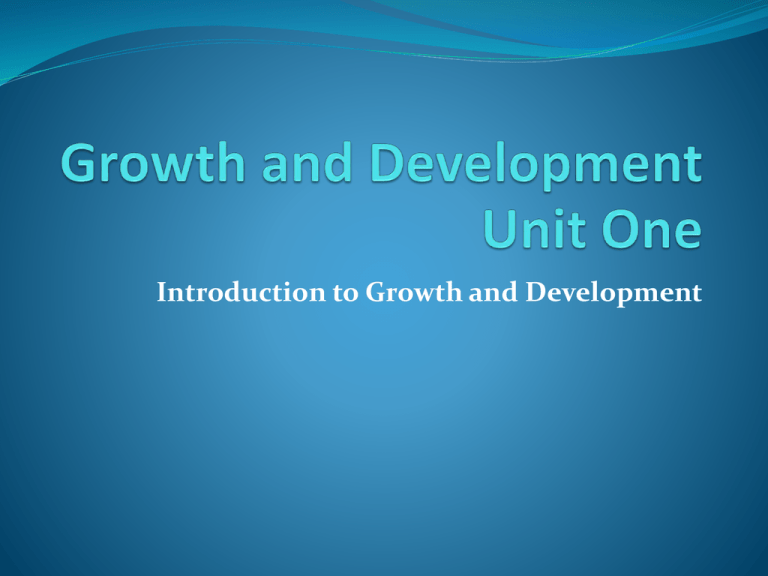Growth and Development Unit One
advertisement

Introduction to Growth and Development Introduction Human life proceeds in stages from infancy to adulthood to senescence. All human beings share the same mechanisms of growth and development and proceed through the same stages of life. The rate of maturation and the final outcome are widely variable because of the expensive and diverse influences on each individual. Introduction Growth may be defined as a physiological process by which the organism assimilates or transforms essential, nonliving nutrients into living protoplasm. Growth involves the incorporation of new materials. Development is defined as a physiological process by which the individual progresses from an undifferentiated state to a highly organized and functional capacity. Development implies an increase in skill and in complexity of function. As growth is measured in pounds and inches, development is measured in abilities Patterns of Growth and Development: The genetic code determines the rate of the growth and development of the various body parts, which occur in synchrony with overall growth and development. For example, at birth the lower limbs of the infant are less well developed than the upper limbs. During the prenatal and postnatal periods, growth and development follow a cephalocaudal pattern, that is development proceeds from head (cephalo) to toe (caudal). The head matures before the neck, the neck before the chest, the chest before the pelvis, and so on. Patterns of Growth and Development: The cephalocaudal and proximodistal patients of growth and development are evident in the motor development of the infant. He rolls over before he can sit; his arm and chest development enable this maneuver. As his trunk and legs develop. Stages of Growth and Development: The human life span can be divided into two distinct biological periods, prenatal and postnatal. The prenatal period includes three stage the ovum, embryo, and fetus. Postnatal life begins with birth and proceeds through the neonatal period, infancy, adulthood, and sensescence. childhood, adolescence, The progression from one stage to the next is dependent upon completion of the previous stage. Characteristics of Growth and Development: Directional patterns: Are fundamental to the growth of all humans. Cephalocodal development: Proceeds from head to toe. The infant can raise the head before he can sit and gains control of the trunk before walking. Proximo- distal development : Proceeds from inner to outer. the infant is able to control the trunk before arms . General to specific development: The infant grasps with the hands before pinching with fingers. Characteristics of Growth and Development: Metabolic rate: In children is higher than in adults, so infants require more calories, minerals and vitamins and fluid in proportion to weight and height than do adults. The body surface area of young children is far greater in relation to body weight than that of adult. The young child loses more fluid from the pulmonary system and skin. Characteristics of Growth and Development: Bone growth: It is one of the best indicators of biological age. Bone age can be determined from x-ray films. Though ossification cartilage is converted to bone. Growth of long bones continues until epipheseal fusion occurs. Characteristics of Growth and Development: Critical Periods: Are periods when environmental events have their maximal effect on the child's development During the first 3 months of pregnancy, certain viruses and drugs are known to cause congenital anomalies. Characteristics of Growth and Development: Growth Standards: Standards have been developed to: Compare the measurement for any one child with those for other children of the same age, sex & race. Compare that child's present measurements with his own former sate of growth. Percentile charts are customarily designed and divided into 7 percentile levels 95 th , 90 th , 75 th , 50 th , 25 th 10 th and 5 th , Characteristics of Growth and Development: Selected Factors Development : That Influence Growth & Genetic & Hereditary Traits: Inherited traits as hair color, height ... etc... Genetic disorders as the lasemia , achondroplasia ... etc.... Nationality & race: Japanese ---- (was) short, African ----- tall Congenital anomalies: As congenital heart diseases. Nutritional factors: as growth failure is an important feature of protein – energy malnutrition. Chronic diseases: as tuberculosis. Prenatal Period: The most rapid growth and development in the human life cycle occurs in the prenatal period. During the embryonic period, the formation of organs occurs rapidly. In the early fetal period the fetus's length increases rapidly. During the last trimester, the fetus makes rapid gains the weight. Neonatal Life: The neonatal period is defined as the first month of life. The first 24 hours of life comprise the most significant time of this period, as the neonate must take the transition from an intrauterine to atmospheric environment. Infant mortality is highest during this transition. Infancy: Infancy is a period of rapid growth and development. During the first three months of life, the infant gains an average of two pound per month; by five months of age, the birth weight has doubled. The infant also grows rapidly in height. By the end of the first year the infant's length is 50 percent greater than at birth. During this period, the infant brain grows more rapidly than the whole body and attains nearly adult size by two years age. Childhood: The preschool years (age 2 to 6) and the school years (age 6 to 12) represents a period of relatively slow growth. The annual increment in weight averages approximately 5 lb until the ninth or tenth birthday. The height increment during the school years is approximately 2 in each year. During this period, the child's social world expands as he enters school. Adolescence: The adolescent period comprises the years in which the child "grows up," It is a period of profound changes in physical , mental and emotional development. The period is marked by an accelerated gain in weight and height. Adulthood and Aging: The adult years are a period of competency and ability. Unlike the development stages, the adult years do not have a sequence of precisely timed physiological events. This is also true of the aging years from 65 years until death. Stages in the Life Cycle Period Approximate Age on Stage Embryonic First trimester of prenatal life Early fetal Accelerated growth; Second trimester elaboration of structures; early functional of prenatal life. activities Late fetal Third trimester of prenatal life Rapid increase in body mass; completion of preparation for postnatal life Parturient Period of labor and delivery Risk of trauma and anoxia; cessation of placental function Neonatal and early infancy First month of postnatal life Postnatal adjustments in circulation; initiation of respiration and other functions. Some Characteristics Rapid differentiation; establishment of systems and organs Stages in the Life Cycle Period Middle infancy Approximate Age on Stage Some Characteristics 1 mo to 1 yr Rapid growth and maturation; maturation of functions, especially of nervous system 1 to 2 yr Decelerating growth; Progress in waling and other voluntary motor activities, and in control of excretory functions. Preschool 2 to 6 yr Slow growth; increased physical activity; further coordination of functions and motor mechanisms; rapid learning. School Girls : 6 to 10 yr Steady growth; developing skills and Boys : 6 to 12 yr intellectual processes Late infancy Stages in the Life Cycle Period Approximate Age on Stage Prepubertal (late school or Girls 10 to 12 yr early Boys : 12 to 14 yr adolescent) Pubrtal (adolescence proper) Postpubertal Girls : 12 to 14 yr Boys : 14 to 16 yr Some Characteristics Accelerating growth; rapid weight gain; early adolescent endocrine and sex organ changes Maturation of secondary sex characteristics; Maximum postnatal growth increase; decelerating and terminal growth; rapid Girls : 14 to 18 muscle growth and increased skills; rapid yr growth and maturing functions of sex Boys 16 to 20 yr organs; need for self-reliance and independence. Hormonal influence development: on growth and The growth and development of an individual is influenced by four major sources of hormones: the central nervous system, and the thyroid gland, and the adrenal gland, and the gonadal gland. Hormonal influence development: on growth and Although the hormones have different chemical structures and are produced by different organs, they all influence growth and development by stimulating protein synthesis. It is hypothesized that each hormone has its major effect on growth and development at a particular period of life. Hormonal influence development: on growth and Growth Hormone: Growth hormone is secreted by the anterior portion of the pituitary gland in response to growth hormone releasing factor, which is produced by the hypothalamus; under the influence of various stimuli, the hypothalamus controls the anterior pituitary and, thereby, the release of growth hormone. Thus, the pituitary is an intermediary gland. Hormonal influence development: on growth and Growth Hormone: Growth hormone is chiefly influential in protein synthesis. At the cellular level, growth hormone stimulates increased transport of amino acids into cells and increased incorporation of amino acids into protein. The role of growth hormone in the prenatal period has not been clearly delineated. The influence of growth hormone brings about an increase in the child’s height and weight, changes in skeletal proportions and head and face contours, dental development, and ossification of the long bones. Hormonal influence development: on growth and Thyroid Hormones: Thyroxine (T4) and triidothyrodine (T3) are the major thyroid hormones and are secreted by the thyroid gland. Their release is regulated by the hypothalamus and the pituitary gland. The thyroid hormones exert their influence by stimulating protein synthesis. In contrast to growth hormone, thyroid hormones have a great influence on fetal and neonatal growth. In the absence of thyroid hormones during this period, there is a lack of brain growth, probably in both cell number and cell size. Hormonal influence development: on growth and Androgens: An increase in androgens is felt to be responsible for most of the growth and development that takes place during adolescence. The androgens exert their influence like growth hormone and thyroid hormone, i.e. by stimulating protein synthesis. They are responsible for overall growth and skeletal and muscular maturation. Testosterone is the principal androgen produced by the testes. Dehydroepiandrosterone is the principal androgen produced by the adrenal cortex. The androgens and estrogens are responsible for sexual maturation during adolescence. Heredity and Environment: The human organism experiences a lengthy period of growth and development, influenced by internal factors (those that are intrinsic of the individual, i.e., genetic potential) and external factors (those that are outside of the individuals, i.e., environmental influences). As has been said, the final outcome of growth and development is a result of the dynamic interplay of genetic potential and environmental factors. Genetic Potential: The information stored in the genes exerts a tremendous influence on the individual’s maturation. Genetic factors affect the individual’s rate of growth, the time of the onset of the adolescent growth spurt, and the final size and shape of the body. Genetic factors play a leading part in the growth difference between males and females. Boys and girls have different patterns of growth and development, and an obvious difference in final outcome. Girls mature more rapidly than boys throughout the developmental years. Adolescence begins sooner for girls, and they attain sexual maturity and maximum height approximately two year earlier than boys. Genetic Potential: Girls begin their growth spurt at approximately age 10 to 11 years and will have reached adult height by about 16 years. Boys begin their growth spurt at age 12 to 13 years and do not each adult stature until 18 years of age. Genetic factors are also influential in the differences seen in different ethnic groups. Environmental Factors: The environment supplies the external factors that make growth and development possible. Environmental factors include temperature, nutrition, drugs, infections, radiation, and so on. These external factors are influential throughout the life span. The impact of an environmental factor on growth and development is dependent on the characteristics, intensity, duration, and timing of the factors. The organism as a whole, and specific organs, is particularly susceptible to environmental factors during specific stages called critical periods. The central nervous system is very susceptible to environmental factors during the fetal period. Skeletal Growth: Skeletal growth is commonly taken as an index of overall growth and development. Height, a reflection of an individual’s skeletal growth, is a common clinical measure. Bone age may also be used as a clinic measurement of physiological maturity. Bone is a specialized tissue that supports the body and protects vital organs. The human skeleton exits first in the form of connective tissue, then cartilage, and finally bone. The adult skeleton is composed of bone with no remnants of the original membranous skeleton. The closure of the fontanelles in infancy demonstrates this progression from connective tissue to bone in skeletal development. Skeletal Growth: During childhood, cartilage is found throughout the skeleton. The length of the skeleton grows by dint of the proliferation of cartilage. The cartilage changes to bone by the process of ossification. It is through the two processes of cartilage proliferation and ossification that the bones grow. Cartilage is produced in the metaphyses of bones and in the cartilage plate. Ossification proceeds from the epiphysis (end) of the bone, which contains the ossification centers. Skeletal Growth: Skeletal growth and development involves the continual growth of ossification centers; skeletal maturation is initiated by the appearance of ossification centers and is terminated when these centers are fused. The individual has approximately 400 ossification centers at birth, ad twice as many by maturation. New ossification centers appear according to a regular schedule. The growth of new ossification centers is under hormonal control; growth hormone seems to have the most influence on the growth of new ossification centers. The stages of bone growth occur at regular intervals that vary little between individuals. This relative uniformity permits the use of bone age measurement as a reliable index of maturation. Skull Growth: The skull is large at birth because of the relatively large size of the brain. After birth, the skull continues to grow in order to accommodate the very rapid further growth of the brain. In the first two years of life, the skull’s capacity grows from 400ml to 950ml and its circumference increases from about 33cm to 47cm. Skull Growth: At birth, the bones that comprise the cranial vault are separated by gaps filled with fibrous connective tissue; the gaps allows the bones to slide over each other to some extent as the neonate passes through the mother’s narrow birth canal. As ossification of the fibrous connective tissue proceeds, the individual bones come into contact with each other along a series of fibrous joints known as sutures. It is at the sutures that skull growth takes place. Skull growth will continue until after puberty, accommodating the growing brain. After skull growth stops, the sutures will be obliterated by their ossification and fusing together.




